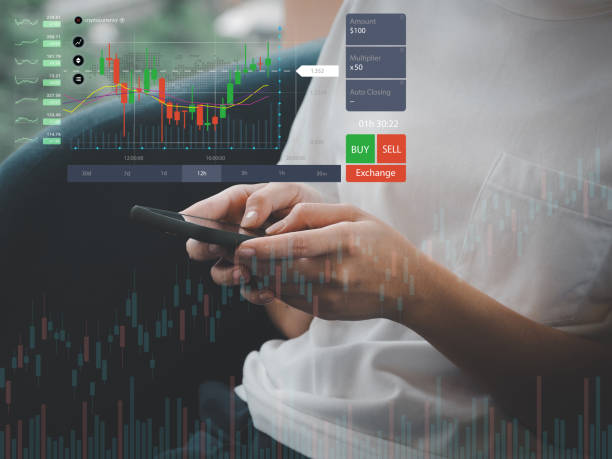Algorithmic day trading, or automated trading, involves using computer algorithms to execute high-frequency trades within a single trading day. Traditionally associated with institutional investors and professional traders, algorithmic trading has become increasingly accessible to retail investors due to technological advancements and the availability of algorithmic trading platforms.
This outline will provide an overview of critical considerations for retail investors interested in algorithmic day trading, including the educational and research aspects, the selection of a reliable algorithmic trading platform, the development and testing of algorithms, risk management strategies, monitoring and adaptation of trading strategies, regulatory compliance, and psychological considerations.
By understanding these essential elements, retail investors can gain insights into the complexities and challenges of algorithmic day trading, allowing them to make informed decisions and effectively navigate the dynamic landscape of high-frequency trading.
Definition of algorithmic day trading
Algorithmic day trading, or automated trading, uses computer algorithms to execute many trades within a single trading day. These algorithms are programmed to analyze market data, identify trading opportunities, and automatically execute buy or sell orders based on predefined criteria. Algorithmic day trading is characterized by its high speed and frequency of trades, often leveraging advanced mathematical models, technical indicators, and historical data to make rapid trading decisions.
Retail investors engage in algorithmic day trading to capitalize on short-term market movements, aiming to profit from small price fluctuations in stocks, currencies, or other financial instruments. Using algorithms allows for swift and precise trade execution, enabling investors to take advantage of fleeting opportunities in the market.
Algorithmic day trading can encompass a variety of strategies, such as trend following, statistical arbitrage, market making, and momentum trading, among others. These strategies are often designed to exploit inefficiencies in the market or capitalize on short-term price patterns.
It’s important to note that algorithmic day trading carries inherent risks, including the potential for rapid and substantial losses. Retail investors engaging in algorithmic day trading should thoroughly understand the strategies they employ and the technical and market dynamics involved in high-frequency trading. Additionally, regulatory compliance and risk management are essential considerations for algorithmic day trading activities.
Evolution of algorithmic trading for retail investors
The evolution of algorithmic trading for retail investors has been marked by several key developments, leading to increased accessibility and participation in this sophisticated trading approach:
- Technological Advancements: The proliferation of advanced trading platforms and the availability of high-speed internet connections have empowered retail investors to engage in algorithmic trading. These technological advancements have enabled individual traders to access real-time market data, execute trades swiftly, and leverage algorithmic strategies from their homes.
- Democratization of Information: Retail investors now have access to financial data, market research, and educational resources through online platforms, financial news outlets, and social media. This democratization of information has facilitated a greater understanding of algorithmic trading strategies and market dynamics, empowering retail investors to make informed decisions and develop algorithmic trading approaches.
- Rise of Algorithmic Trading Platforms: The emergence of user-friendly algorithmic trading platforms tailored to retail investors has played a pivotal role in the evolution of algorithmic trading. These platforms offer intuitive interfaces, robust technical analysis tools, and algorithm libraries that allow retail traders to develop, backtest, and deploy their trading algorithms without extensive programming knowledge.
- Access to Market Liquidity and Assets: Retail investors now have access to a wide range of financial instruments, including stocks, options, futures, and currencies, across various global markets. This access to diverse asset classes and market liquidity has expanded the opportunities for retail investors to apply algorithmic trading strategies to different segments of the financial markets.
- Regulatory Changes and Compliance: Regulatory changes and advancements in investor protection measures have contributed to a more transparent and secure trading environment for retail investors. Increased regulatory oversight has helped enhance market integrity and provided retail traders a more level playing field when engaging in algorithmic trading activities.
- Educational Resources and Community Support: The availability of educational resources, online tutorials, and communities of algorithmic traders has facilitated the learning and sharing knowledge among retail investors. This supportive ecosystem has empowered individual traders to develop their algorithmic trading skills and gain insights from experienced practitioners.
Overall, the evolution of algorithmic trading for retail investors has been driven by technological innovation, increased access to information and resources, and a more inclusive trading landscape. These factors have contributed to the growing participation of retail investors in algorithmic trading, offering new opportunities for individuals to engage in sophisticated trading strategies previously dominated by institutional players.
Potential benefits and risks
Potential Benefits of Algorithmic Day Trading for Retail Investors:
- Automation and Efficiency: Algorithmic trading allows for the automation of trade execution, enabling swift and precise order placement without manual intervention. This can help retail investors capitalize on short-term trading opportunities and reduce the impact of human emotions on trading decisions.
- Access to High-Frequency Strategies: Retail investors can leverage high-frequency trading strategies, such as scalping or market-making, to profit from small price movements within a single trading day. Algorithmic trading facilitates the rapid execution of these strategies, potentially capturing numerous small gains throughout the day.
- Diversification of Trading Strategies: Algorithmic trading allows retail investors to diversify their trading strategies beyond traditional buy-and-hold approaches. By deploying algorithmic strategies, investors can access a broader range of trading techniques, including trend following, statistical arbitrage, and quantitative modeling.
- Backtesting and Optimization: Retail investors can backtest and optimize their trading algorithms using historical data, allowing them to assess the performance of their strategies under various market conditions. This process can help refine trading algorithms and improve their potential effectiveness.
- Potential for Reduced Transaction Costs: Algorithmic trading may lead to reduced transaction costs, as it can minimize the impact of bid-ask spreads and optimize trade execution, particularly in high-frequency trading scenarios.
Potential Risks of Algorithmic Day Trading for Retail Investors:
- Market Volatility and Liquidity Risks: Algorithmic day trading strategies are susceptible to market volatility and liquidity risks, as rapid price movements and thin trading volumes can impact trade execution and result in unexpected losses.
- Technological Risks: The reliance on technology for algorithmic trading introduces the risk of technical glitches, system failures, or connectivity issues that could disrupt trade execution and lead to financial losses.
- Over-Optimization and Curve Fitting: Over-optimizing trading algorithms based on historical data can lead to curve fitting, where strategies perform well in backtests but underperform in live trading due to overfitting past market conditions.
- Regulatory and Compliance Risks: Retail investors engaging in algorithmic trading must navigate regulatory requirements, compliance standards, and potential legal implications of high-frequency trading activities.
- Psychological Challenges: Algorithmic day trading can pose psychological challenges, including the potential for increased stress, emotional fatigue, and the temptation to deviate from trading strategies in response to short-term market fluctuations.
- Learning Curve and Expertise: Retail investors need to acquire a deep
Education and Research
Education and research are crucial for retail investors seeking algorithmic day trading. Understanding the intricacies of algorithmic trading strategies, technical analysis, and market dynamics is essential for developing effective trading approaches. Here are key aspects of education and research for retail investors:
- Understanding Algorithmic Trading Strategies:
-
- Familiarize with algorithmic trading strategies, such as trend following, mean reversion, and statistical arbitrage.
- Learn about quantitative modeling, high-frequency trading techniques, and the application of mathematical models in trading.
- Technical Analysis and Market Indicators:
-
- Gain knowledge of technical analysis tools, including moving averages, oscillators, and chart patterns, to identify potential trade signals.
- Understand market indicators, such as volume analysis, volatility measures, and momentum indicators, in algorithmic trading.
- Algorithmic Trading Platforms:
-
- Research and compare algorithmic trading platforms to identify user-friendly interfaces, robust technical analysis tools, and algorithm development capabilities.
- Explore the features of algorithmic trading platforms, including real-time market data, backtesting capabilities, and order execution speed.
- Backtesting and Simulation:
-
- Learn the importance of backtesting and simulating trading algorithms using historical market data to evaluate their performance.
- Understand optimizing trading algorithms and assessing their robustness under different market conditions.
- Risk Management and Position Sizing:
-
- Educate yourself on risk management principles, including using stop-loss orders, position-sizing strategies, and risk controls to mitigate potential losses.
- Research the impact of leverage, margin requirements, and portfolio diversification in algorithmic trading.
- Market Dynamics and Regulatory Considerations:
-
- Stay informed about market dynamics, including the impact of economic indicators, news events, and global macroeconomic factors on trading strategies.
- Understand regulatory considerations, compliance standards, and legal implications associated with algorithmic trading activities.
- Continuous Learning and Adaptation:
-
- Emphasize the importance of continuous learning, staying updated with market trends, and adapting trading strategies to changing market conditions.
- Engage with educational resources, online forums, and communities of algorithmic traders to gain insights and share knowledge.
By focusing on education and research, retail investors can build a solid foundation for algorithmic day trading, develop informed trading strategies, and navigate the complexities of high-frequency trading with greater confidence.
Selecting a Reliable Algorithmic Trading Platform
Selecting a reliable algorithmic trading platform is critical for retail investors looking to engage in algorithmic day trading. The platform is the foundation for developing, testing, and executing trading algorithms. Here are key considerations for selecting a reliable algorithmic trading platform:
- User-Friendly Interface:
-
- Look for a platform with an intuitive and user-friendly interface that allows easy navigation, efficient order placement, and access to essential trading tools.
- Technical Analysis Tools:
-
- Ensure the platform offers robust technical analysis tools, including charting capabilities, indicators, and drawing tools for analyzing market trends and identifying trade opportunities.
- Algorithm Development Capabilities:
-
- Choose a platform with algorithm development capabilities, allowing retail investors to create, modify, and test trading algorithms using a programming language or a visual interface.
- Real-Time Market Data:
-
- Verify that the platform provides access to real-time market data, including price quotes, order book depth, and trade execution data for timely decision-making.
- Backtesting and Simulation Features:
-
- Look for a platform that offers comprehensive backtesting and simulation features, enabling users to assess the historical performance of trading algorithms and optimize strategies before live deployment.
- Order Execution Speed:
-
- Assess the platform’s order execution speed and reliability, as fast and efficient trade execution is essential for high-frequency trading strategies.
- Brokerage Integration:
-
- Consider platforms that integrate with reputable brokerage firms, providing seamless connectivity for executing trades and managing accounts within the platform.
- Risk Management Tools:
-
- Evaluate the platform’s risk management tools, such as setting stop-loss orders, position sizing parameters, and risk control features to manage potential losses.
- Customer Support and Education:
-
- Look for platforms that offer comprehensive customer support, educational resources, and documentation to assist users in navigating the platform and developing trading strategies.
- Security and Reliability:
-
- Prioritize platforms emphasizing security measures, data encryption, and reliability to safeguard trading activities and user information.
- Cost and Pricing Structure:
-
- Consider the cost and pricing structure of the platform, including subscription fees, commission rates, and any additional charges associated with using the platform’s features.
By carefully evaluating these considerations, retail investors can select a reliable algorithmic trading platform that aligns with their trading objectives, technical requirements, and risk management preferences, ultimately supporting their algorithmic day trading activities.
Developing and Testing Algorithms
Developing and testing algorithms is a crucial aspect of algorithmic day trading for retail investors. Here are key considerations for developing and testing trading algorithms:
- Define Trading Objectives:
-
- Clearly define the trading objectives, including profit goals, risk tolerance, and the specific market conditions the algorithm aims to capitalize on.
- Select a Programming Language or Platform:
-
- Choose a programming language or algorithmic trading platform that aligns with your technical expertise and allows for the development of trading algorithms. Common languages include Python, R, and MetaTrader or NinjaTrader platforms.
- Algorithm Design and Logic:
-
- Develop the logic and rules that govern the trading algorithm, considering factors such as entry and exit signals, position sizing, risk management, and order execution parameters.
- Historical Data Collection:
-
- Gather historical market data relevant to the asset or market the algorithm will trade in, ensuring the data covers a sufficient time period and includes various market conditions.
- Backtesting:
-
- Utilize historical data to backtest the trading algorithm, simulating its performance over past market conditions to assess its effectiveness, profitability, and risk exposure.
- Optimization:
-
- Optimize the trading algorithm by adjusting parameters, testing variations, and refining the strategy to enhance its performance and adaptability to changing market conditions.
- Simulation:
-
- Conduct simulated trading using historical data to evaluate the algorithm’s performance under realistic market conditions, including slippage, transaction costs, and order execution delays.
- Robustness Testing:
-
- Test the algorithm’s robustness by subjecting it to stress tests, extreme market conditions, and sensitivity analysis to gauge its resilience and ability to perform across various scenarios.
- Risk Management Integration:
-
- Integrate risk management components into the algorithm, such as stop-loss mechanisms, position sizing rules, and risk controls to mitigate potential losses and manage overall portfolio risk.
- Real-Time Testing:
-
- Once satisfied with the algorithm’s performance in backtesting and simulation, conduct real-time testing in a controlled environment to validate its behavior and performance in live market conditions.
- Continuous Monitoring and Adaptation:
-
- Continuously monitor the algorithm’s performance, analyze its results, and make necessary adjustments to adapt to changing market dynamics and optimize its performance over time.
By following these steps, retail investors can effectively develop and test trading algorithms, ensuring they are well-prepared to deploy robust and effective strategies for algorithmic day trading.
Risk Management
Risk management is a critical aspect of algorithmic day trading for retail investors. Effectively managing risks can help mitigate potential losses and safeguard trading capital. Here are key considerations for implementing risk management strategies:
- Position Sizing:
-
- Determine the appropriate position size for each trade based on the algorithm’s risk parameters, account size, and confidence level in the trade setup. Position sizing helps control the impact of individual trades on the overall portfolio.
- Stop-Loss Orders:
-
- Implement stop-loss orders to define the maximum acceptable loss for each trade. This helps limit potential losses by automatically closing out a position if the market moves against the trade beyond a predetermined threshold.
- Diversification:
-
- Diversify the trading portfolio across different assets, markets, and trading strategies to spread risk and reduce the impact of adverse movements in any single position.
- Risk-Reward Ratio:
-
- Assess the risk-reward ratio for each trade, aiming to identify opportunities where potential gains outweigh potential losses. This ratio helps evaluate the trade’s profitability relative to the risk involved.
- Risk Limits:
-
- Establish risk limits for the overall trading portfolio, setting maximum exposure levels for different asset classes, market conditions, and trading strategies to prevent overexposure to specific risks.
- Monitoring and Analysis:
-
- Regularly monitor the performance of trading algorithms, analyze the outcomes of individual trades, and assess the portfolio’s overall risk profile to identify improvement areas.
- Contingency Planning:
-
- Develop contingency plans and risk mitigation strategies to address unexpected market events, system failures, or adverse trading conditions that could impact the algorithm’s performance.
- Stress Testing:
-
- Subject the trading algorithms to stress tests and scenario analysis to evaluate their resilience under extreme market conditions and assess the potential impact on the portfolio.
- Risk Reporting and Documentation:
-
- Maintain comprehensive records of trades, risk assessments, and risk management decisions to track the effectiveness of risk management strategies and facilitate continuous improvement.
- Adherence to Regulatory Requirements:
-
- Ensure compliance with regulatory requirements, including margin rules, position limits, and other regulatory obligations that impact risk management in algorithmic trading.
By integrating these risk management considerations into algorithmic day trading activities, retail investors can enhance the resilience of their trading strategies, minimize potential losses, and navigate the dynamic and often unpredictable nature of financial markets with greater confidence.
Monitoring and Adaptation
Monitoring and adaptation are essential components of successful algorithmic day trading for retail investors. Continuous oversight and the ability to adapt trading strategies to changing market conditions are crucial for maintaining a competitive edge and optimizing trading performance. Here are key considerations for monitoring and adaptation in algorithmic trading:
- Real-Time Market Monitoring:
-
- Continuously monitor real-time market data, including price movements, volume, and order flow, to stay informed about current market conditions and identify potential trade opportunities.
- Performance Tracking:
-
- Track the performance of trading algorithms, including individual trade outcomes, portfolio returns, and risk metrics, to assess their effectiveness and identify areas for improvement.
- Market Analysis:
-
- Conduct ongoing market analysis to identify trends, patterns, and emerging opportunities, leveraging technical analysis, fundamental research, and market news to inform trading decisions.
- Trade Execution Analysis:
-
- Analyze trade execution data, including slippage, order fills, and transaction costs, to evaluate the efficiency and impact of trade execution on overall trading performance.
- Risk Assessment:
-
- Regularly assess the risk exposure of the trading portfolio, including position sizes, risk-reward ratios, and overall risk limits, to ensure that risk management strategies remain effective.
- Adapting to Changing Market Conditions:
-
- Adapt trading strategies to changing market conditions, adjusting parameters, trade criteria, and risk management rules to optimize performance and capitalize on evolving market dynamics.
- Backtesting and Optimization:
-
- Continuously backtest and optimize trading algorithms using updated market data to ensure they remain effective and adaptable to current market environments.
- Scenario Analysis:
-
- Conduct scenario analysis and stress tests to assess the resilience of trading algorithms under different market scenarios, including adverse conditions and extreme events.
- Continuous Learning:
-
- Stay informed about market trends, new trading techniques, and technological advancements in algorithmic trading through ongoing education, research, and engagement with the trading community.
- Adaptation to Regulatory Changes:
-
- Stay abreast of regulatory developments and adapt trading strategies to comply with evolving regulatory requirements and industry best practices.
By integrating these considerations into their trading activities, retail investors can effectively monitor market conditions, adapt trading strategies, and maintain a dynamic and responsive approach to algorithmic day trading, ultimately enhancing their potential for success in the financial markets.
Regulatory Compliance
Regulatory compliance is a crucial aspect of algorithmic day trading for retail investors. Adhering to relevant regulations and compliance standards is essential for ensuring trading activities’ legality, transparency, and ethical conduct. Here are key considerations for regulatory compliance in algorithmic trading:
- Understand Applicable Regulations:
-
- Familiarize yourself with the regulatory framework that governs algorithmic trading in your jurisdiction, including securities laws, exchange rules, and regulatory guidelines specific to automated trading.
- Compliance with Market Integrity Rules:
-
- Ensure that algorithmic trading activities comply with market integrity rules, including prohibitions on market manipulation, insider trading, and other abusive trading practices.
- Order Handling and Best Execution:
-
- Adhere to order handling requirements and best execution obligations, ensuring that trades are executed promptly and at the most favorable terms for clients, considering price, speed, and likelihood of execution.
- Risk Controls and Circuit Breakers:
-
- Implement risk controls and circuit breakers to manage the potential impact of algorithmic trading on market stability, including mechanisms to mitigate excessive volatility and prevent disorderly trading.
- Pre-Trade Risk Checks:
-
- Conduct pre-trade risk checks to assess the potential impact of orders on the market and ensure that trading algorithms comply with risk limits and position constraints.
- Market Access and Connectivity:
-
- Comply with market access and connectivity requirements, including direct market access (DMA) and sponsored access rules, to ensure proper authorization and oversight of trading activities.
- Reporting and Record Keeping:
-
- Maintain accurate records of trading activities, including order details, trade executions, and compliance documentation, to facilitate regulatory reporting and oversight.
- Compliance Monitoring and Surveillance:
-
- Establish compliance monitoring and surveillance processes to detect and address potential regulatory requirements, market rules, and internal policy violations.
- Algorithmic Trading Controls:
-
- Implement controls and safeguards to ensure the integrity and reliability of algorithmic trading systems, including testing, monitoring, and system resilience measures.
- Education and Training:
-
- Provide education and training to personnel involved in algorithmic trading to ensure they understand and comply with regulatory requirements and ethical standards.
- Engagement with Regulatory Authorities:
-
- Engage with regulatory authorities, industry associations, and legal advisors to stay informed about regulatory developments, seek guidance on compliance matters, and participate in industry discussions related to algorithmic trading regulation.
By prioritizing regulatory compliance, retail investors can uphold the integrity of their
Psychological Considerations
In algorithmic day trading, retail investors must consider the psychological aspects impacting their decision-making and overall trading performance. While algorithmic trading relies on automated strategies, traders still play a crucial role in developing, monitoring, and adapting these algorithms. Here are key psychological considerations for retail investors engaged in algorithmic day trading:
- Emotion Management:
-
- Even though algorithmic trading removes the emotional aspect of individual trade decisions, traders may still experience emotional reactions to market volatility, drawdowns, or unexpected outcomes. It’s important to manage emotions to avoid impulsive actions that could disrupt the trading strategy.
- Discipline and Consistency:
-
- Maintaining discipline and adhering to the predefined trading rules and risk management parameters is crucial. This includes following the algorithm’s signals and avoiding the temptation to override the system based on emotional impulses.
- Patience and Long-Term Perspective:
-
- Algorithmic trading often involves a series of trades over time. Retail investors should maintain patience and focus on the long-term performance of the trading strategy rather than being swayed by short-term fluctuations or individual trade outcomes.
- Continuous Learning and Adaptation:
-
- The ability to adapt and learn from both successful and unsuccessful trades is essential. This requires a growth mindset and a willingness to continuously improve trading algorithms based on market feedback and changing conditions.
- Stress Management:
-
- Algorithmic trading can still be stressful, especially during periods of market volatility. Implementing stress management techniques, such as regular breaks, exercise, and maintaining a healthy work-life balance, can help maintain mental well-being.
- Confidence and Self-Awareness:
-
- Building confidence in the trading strategy while maintaining self-awareness of personal biases and limitations is important. This can involve seeking feedback from peers and mentors or utilizing trading journals for self-reflection.
- Risk Perception and Tolerance:
-
- Understanding personal risk perception and tolerance is crucial. This includes aligning the algorithm’s risk parameters with the trader’s risk appetite and ensuring the trading strategy aligns with their risk management preferences.
- Adaptation to Market Conditions:
-
- Being adaptable to changing market conditions and open to adjusting trading strategies based on evolving market dynamics is essential for long-term success.
By considering these psychological factors, retail investors can enhance their ability to effectively engage in algorithmic day trading, maintain a disciplined approach, and optimize the performance of their trading strategies.
Custom Algorithmic Development
Custom algorithmic development involves creating unique trading algorithms tailored to specific trading objectives, market conditions, and risk preferences. As a retail investor, engaging in custom algorithmic development can provide a competitive edge and enable you to capitalize on opportunities in the financial markets. Here are the key steps involved in custom algorithmic development:
- Define Trading Objectives:
-
- Clearly outline your trading objectives, including profit goals, risk tolerance, and the specific market conditions or assets you intend to trade.
- Market Analysis:
-
- Conduct thorough market analysis to identify patterns, trends, and potential trade opportunities. Understand the dynamics of the financial instruments you wish to trade.
- Algorithm Design:
-
- Develop the logic and rules governing the custom algorithm, including entry and exit signals, position sizing, risk management parameters, and order execution criteria.
- Data Collection and Analysis:
-
- Gather historical market data and conduct in-depth analysis to inform the development of the algorithm. This data will help validate the algorithm’s effectiveness under various market conditions.
- Backtesting:
-
- Utilize historical data to backtest the custom algorithm, simulating its performance over past market conditions to assess its effectiveness, profitability, and risk exposure.
- Optimization:
-
- Refine and optimize the algorithm based on the backtesting results, adjusting parameters and criteria to enhance its performance and adaptability to changing market conditions.
- Risk Management Integration:
-
- Integrate robust risk management components into the algorithm, including stop-loss mechanisms, position sizing rules, and other risk controls to protect against potential losses.
- Real-Time Testing:
-
- Conduct real-time testing of the custom algorithm in a simulated environment to validate its behavior and performance under live market conditions.
- Continuous Monitoring and Adaptation:
-
- Continuously monitor the performance of the custom algorithm, analyze its results, and make necessary adjustments to adapt to changing market dynamics and optimize its performance over time.
- Compliance Considerations:
-
- Ensure that the custom algorithm complies with relevant regulatory requirements, market integrity rules, and best practices for algorithmic trading.
Retail investors can develop custom algorithms tailored to their specific trading objectives and market conditions by following these steps. This approach can provide a strategic advantage in algorithmic trading, allowing for the implementing of unique and adaptive strategies to capitalize on opportunities in the financial markets.
Backtesting Best Practices
Backtesting is a critical component of algorithmic trading and involves testing a trading strategy using historical market data to evaluate its performance. Here are some best practices for backtesting algorithmic trading strategies:
- Quality Data:
-
- Use high-quality historical market data that accurately represents the trading environment, including price, volume, and order flow information.
- In-Sample and Out-of-Sample Testing:
-
- Divide the historical data into in-sample and out-of-sample periods. The in-sample data is used to develop and optimize the strategy, while the out-of-sample data is used to validate its performance.
- Realistic Assumptions:
-
- Make realistic assumptions about transaction costs, slippage, and other trading expenses to accurately reflect the actual trading environment.
- Robustness Testing:
-
- Test the strategy across market conditions, asset classes, and periods to assess its robustness and adaptability to various scenarios.
- Parameter Sensitivity Analysis:
-
- Conduct sensitivity analysis to assess the impact of different parameter values on the strategy’s performance and identify optimal settings.
- Statistical Significance:
-
- Use statistical measures to evaluate the significance of the strategy’s performance, such as the Sharpe ratio, maximum drawdown, and statistical tests to determine if the results are statistically significant.
- Risk Management Simulation:
-
- Incorporate risk management rules into the backtesting process to assess the impact of risk controls, position sizing, and stop-loss mechanisms on the strategy’s performance.
- Out-of-Sample Validation:
-
- Validate the strategy’s performance using out-of-sample data to ensure it can generalize well to new market conditions and is balanced with the in-sample data.
- Realistic Execution:
-
- Simulate realistic trade execution by accounting for order fill rates, market impact, and liquidity constraints to accurately reflect actual trading conditions.
- Documentation and Analysis:
-
- Document the backtesting process, including the rationale behind strategy decisions, assumptions made, and the results of the analysis. This documentation can provide insights for future strategy refinement.
By following these best practices, retail investors can conduct thorough and rigorous backtesting of their algorithmic trading strategies, leading to more robust and reliable trading algorithms. This approach can help identify effective trading strategies, validate their performance, and improve decision-making in algorithmic trading.
Platform-Specific Algorithms
Platform-specific algorithms are tailored to the capabilities and features of a particular trading platform or software. Retail investors often develop these algorithms to take advantage of their chosen trading platform’s unique tools and functionalities. Here are some key considerations for creating platform-specific algorithms:
- Understanding Platform Features:
-
- Gain a thorough understanding of the features and capabilities offered by the trading platform. This includes analyzing the available technical indicators, order types, and backtesting tools.
- Leveraging Platform Tools:
-
- Identify the tools and resources the platform provides, such as custom indicators, charting capabilities, and API integration, that can be utilized in algorithmic trading strategies.
- Platform Limitations:
-
- Recognize any limitations or constraints of the trading platform, such as data availability, execution speed, or order placement restrictions, and adapt the algorithm to work within these constraints.
- Custom Indicators and Signals:
-
- Develop custom indicators or signals using the platform’s programming interface or scripting language to create unique trading signals tailored to the platform’s capabilities.
- Backtesting and Optimization:
-
- Utilize the platform’s backtesting and optimization features to test and refine the algorithm, taking advantage of the specific testing environment provided by the platform.
- Integration with Platform APIs:
-
- If the platform offers an API, consider integrating the algorithm with the API to access real-time market data, execute trades, and leverage additional functionalities provided by the platform.
- Platform-Specific Risk Management:
-
- Implement risk management components that align with the platform’s capabilities, such as utilizing built-in order types for risk control or incorporating platform-specific risk assessment tools.
- Community and Support:
-
- Engage with the platform’s user community and support resources to gain insights, share experiences, and learn about best practices for developing platform-specific algorithms.
- Regulatory Compliance:
-
- Ensure that the platform-specific algorithm complies with regulatory requirements and aligns with the platform’s policies on algorithmic trading and automated strategies.
- Continuous Adaptation:
-
- Continuously adapt the algorithm to leverage new features or updates introduced by the platform, staying informed about any changes that may impact the algorithm’s performance.
By tailoring algorithms to the specific features and capabilities of a trading platform, retail investors can maximize the potential of their trading strategies and take advantage of the tools and resources provided by the platform. This approach can lead to more effective and efficient algorithmic trading, leveraging the unique offerings of the chosen trading platform.
Conclusion
In conclusion, engaging in algorithmic day trading as a retail investor requires careful consideration of various factors to ensure success in the dynamic and competitive financial markets. Selecting a reliable algorithmic trading platform, developing and testing algorithms, implementing risk management strategies, monitoring and adapting to market conditions, ensuring regulatory compliance, and addressing psychological considerations are all critical aspects of algorithmic trading.
Retail investors can establish a solid foundation for algorithmic day trading by prioritizing these considerations. This includes leveraging advanced technology and data analysis to develop effective trading algorithms, managing risk to protect trading capital, adhering to regulatory requirements, and addressing the psychological aspects that impact decision-making and trading performance. Ultimately, a comprehensive approach that integrates these considerations can help retail investors navigate the complexities of algorithmic day trading, optimize trading strategies, and work towards achieving their trading objectives in the financial markets.








Recent Comments